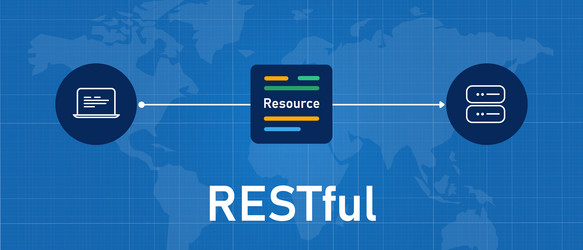Understanding RESTful APIs with Node.js and Express
 Amod
Amod
Building a RESTful API can seem like a complex task, but at its core, it's about creating a web service that follows REST (Representational State Transfer) principles. In this guide, we'll explore the theory behind RESTful APIs using Node.js and Express, to illustrate key concepts.
What is a RESTful API?
RESTful APIs are a way to expose functionalities of your application to other developers or systems in a standardized way. They follow a set of principles:
Resource-Based Routing:
Resource-based routing is a fundamental concept in RESTful API design, emphasizing the idea that everything in your application is a resource. These resources are entities that your API exposes and manages, such as users, products, or articles. Resource-based routing involves organizing your API endpoints around these resources to provide a clear and consistent structure.
In REST, everything is a resource. Resources are entities your application works with, such as users, products, or articles.
Routes in your API represent these resources. For instance,
/userscould represent a collection of users.Naming Conventions:
Establish clear and intuitive naming conventions for your resources. Use plural nouns to represent collections of resources (e.g.
/usersfor a collection of users) and singular nouns for individual resource instances (e.g.,/users/{userId}for a specific user).Example of Resource-Based Routing:
Let's consider a simple scenario where we are building an API for managing articles. Our resources are articles, and we want to perform operations like retrieving all articles, getting a specific article, creating a new article, updating an existing article, and deleting an article.
Retrieve all articles (GET):
Endpoint:
/articlesAction: Get a collection of all articles.
Retrieve a specific article (GET):
Endpoint:
/articles/{articleId}Action: Get details of a specific article identified by
{articleId}.
Create a new article (POST):
Endpoint:
/articlesAction: Create a new article by sending the necessary data in the request body.
Update an existing article (PUT or PATCH):
Endpoint:
/articles/{articleId}Action: Update the details of a specific article identified by
{articleId}. UsePUTto replace the entire resource orPATCHto update specific fields.
Delete an article (DELETE):
Endpoint:
/articles/{articleId}Action: Delete the article identified by
{articleId}
Detailed information about the methods is below:
HTTP Methods:
RESTful APIs use standard HTTP methods to perform operations on resources.
GETis used to retrieve a resource,POSTto create,PUTto update, andDELETEto delete.GET: Retrieving Resources
- The
GETmethod is used to retrieve data from a specified resource. It's a read-only operation and does not modify the resource on the server. Examples include fetching a list of users (/users) or retrieving details of a specific article (/articles/{articleId}).
- The
POST: Creating Resources
POSTis used to submit data to be processed to a specified resource, resulting in the creation of a new resource. This method is often used for actions like creating a new user (/users) or adding a new article (/articles).
PUT: Updating Resources
- The
PUTmethod is employed to update a specified resource or create it if it doesn't exist. It typically replaces the entire resource with the new data. For instance, updating the details of a user (/users/{userId}) or modifying an article (/articles/{articleId}).
- The
PATCH: Partially Updating Resources
PATCHis similar toPUT, but it's used for partial updates. Instead of replacing the entire resource,PATCHapplies modifications to specific fields. It's useful when you only need to update certain properties of a resource.
DELETE: Deleting Resources
DELETEis utilized to request the removal of a specified resource. This method results in the deletion of the resource on the server. For example, deleting a user (/users/{userId}) or removing an article (/articles/{articleId}).
Statelessness:
Statelessness is a fundamental principle in RESTful API design, emphasizing that each request from a client to a server should contain all the information necessary to understand and fulfill that request. In other words, the server should not store any information about the client's state between requests. This design philosophy provides several advantages, including simplicity, scalability, and improved reliability.
Key Aspects of Statelessness:
Independence of Requests:
- Every request sent by a client to the server must include all the information required for the server to comprehend and respond effectively. This includes authentication credentials, session details, and any data relevant to the specific operation.
No Session State on the Server:
- Unlike traditional web applications that may rely on maintaining session state on the server, stateless APIs treat each request as an independent and complete transaction. The server doesn't store information about the client's session between requests.
Scalability:
- Stateless APIs are inherently scalable because each request is self-contained. Servers can easily distribute incoming requests across multiple instances, as there is no reliance on shared session data. This makes it easier to handle increased traffic and ensures better horizontal scalability.
Representations:
Representations in RESTful API development refer to the way resources are presented, formatted, and communicated between clients and servers. In a RESTful architecture, resources are identified by URIs, and their state is exchanged through representations. Representations can take various formats, with JSON and XML being two common examples. The choice of representation format is important, as it influences how clients and servers interact with each other.
Clients interact with these representations to perform operations on resources(explained above).
Key Concepts of Representations:
Resource State Representation:
- Representations encapsulate the current state of a resource. This state can include metadata, and links to related resources. For example, a representation of a user resource may include their name, email, and a link to their profile picture.
Content Negotiation:
- Content negotiation is the process by which clients and servers agree on the format of representations. This negotiation occurs through the
Acceptheader in the request, where clients specify their preferred representation format (e.g., JSON or XML), and servers respond accordingly to that.
- Content negotiation is the process by which clients and servers agree on the format of representations. This negotiation occurs through the
Common Representation Formats:
- JSON (JavaScript Object Notation) and XML (eXtensible Markup Language) are widely used representation formats in RESTful APIs. JSON is more common due to its simplicity, ease of use, and readability.
Let me know your thoughts in the comments below.
#Explore. Code. Evolve.
Happy coding! 😄
Subscribe to my newsletter
Read articles from Amod directly inside your inbox. Subscribe to the newsletter, and don't miss out.
Written by
